Pesticide usage in Scotland: rodenticides on arable farms 2016
This report presents the results of a survey of rodenticide use on arable farms in Scotland in 2016.
This document is part of a collection
Results and comparison with previous surveys
Proportion of farms using rodenticides and type of user
It was estimated that 78 per cent of Scottish arable farms used rodenticides in 2016 (Figure 1). On farms where rodenticides were used, it was estimated that farmers applied rodenticides on 60 per cent of holdings and Pest Control Professionals ( PCPs) conducted the baiting on the remaining 40 per cent. However, despite the fact that on the majority of farms baiting was conducted by farmers; it was estimated that farmers and PCPs used similar amounts of rodenticides overall (52 and 48 per cent of total use by weight respectively).
Figure 1 Number of arable farms using rodenticides and type of user 2016
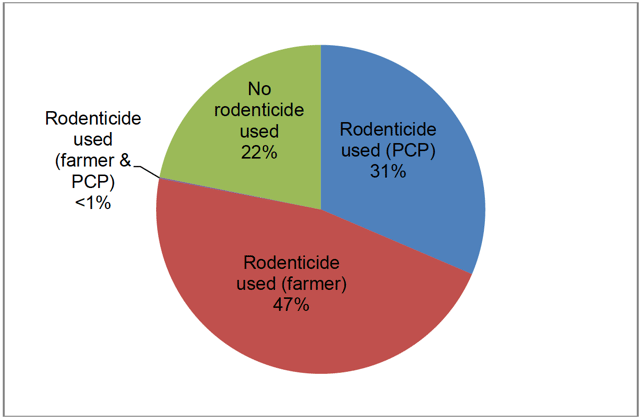
Note: in previous reports farmer and PCP use was based on sample data rather than an estimation of the pattern in the total population (refer to Appendix 5)
The estimated percentage of farms using rodenticides, and associated user type, in the previous two surveys (2012 and 2014) is presented in Figure 2. The percentage of farms using rodenticides in 2016 was similar to that reported in 2012 and 2014 (78 and 71 per cent respectively), with a majority of arable holdings employing chemical rodent control throughout this period.
The proportion of holdings using rodenticides on which farmers conducted baiting in 2016 (60 per cent) was similar to that encountered in previous surveys (57 and 54 per cent in 2012 and 2014 respectively). However, perhaps unsurprisingly as PCPs are more likely to be used in the case of heavy rodent infestations, PCPs applied the same or more rodenticides in total than farmers. PCPs applied 59, 62 and 48 per cent of rodenticides by weight in 2012, 2014 and 2016 respectively (Figure 3).
Figure 2 Pattern of rodenticide use, and type of user conducting baiting, on arable farms in Scotland 2012 to 2016
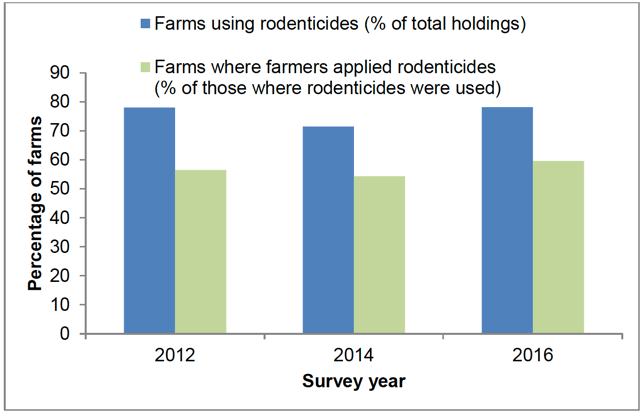
Figure 3 Weight of rodenticides applied, to arable holdings, by farmers and PCPs in Scotland 2012 to 2016
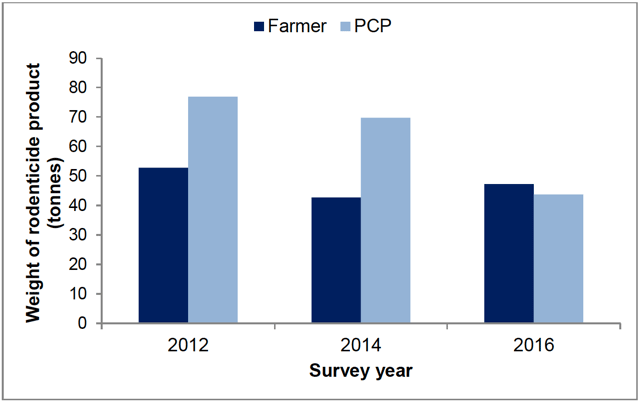
Rodenticides encountered and their estimated occurrence
During this survey product information was recorded for 96 per cent of all occurrences of rodenticide use. For the remaining four per cent, whilst it was recorded that rodenticides had been applied, the product used was not specified. This was either a result of farmers not having records of the product used or PCPs not responding to requests for details of use. The following sections only discuss specified use of rodenticides.
All seven active substances encountered during this survey ( Table 1 & Figure 4) were anticoagulant rodenticides, which prevent the synthesis of blood clotting factors and result in death by haemorrhage. Five were second generation anticoagulant rodenticides ( SGARs), and these compounds collectively accounted for more than 99 per cent of all occurrences of specified rodenticide use.
Figure 4 Estimated percentage occurrence of specified rodenticide active substances on arable farms in Scotland 2016

Note: as there were 10 or fewer occurrences of coumatetralyl, chlorophacinone, difethialone and flocoumafen in the sample, estimates of their use should be treated with caution
The most commonly encountered active substances were bromadiolone and difenacoum (45 and 47 per cent of all occurrences respectively). More limited use of brodifacoum, flocoumafen and difethialone was also recorded; accounting for six, one and <1 per cent of total occurrences respectively. The dominance of difenacoum and bromadiolone use reflects their being the most commonly available rodenticides. They currently account for 78 per cent of all rodenticide product approvals, 80 per cent of those approved outdoors and are the only SGAR compounds with approval for use in open areas (3) .
Of the two first generation anticoagulant rodenticides ( FGARs), approved during the survey period (coumatetralyl and warfarin), only coumatetralyl was encountered (<1 per cent of occurrences). The survey also encountered a single unapproved occurrence of the withdrawn FGAR active substance chlorophacinone.
The percentage occurrence of rodenticide active substances on arable farms from 2012 to 2016 is presented in Figure 5. Over this time series rodenticide use has been almost exclusively composed of SGARs (99, 100 and >99 per cent in 2012, 2014 and 2016 respectively, no significant difference amongst years). In contrast, in 2000, FGAR compounds accounted for 20 per cent of total occurrence of use (4) .
The combined use of difenacoum and bromadiolone has changed little over time, accounting for 95, 97 and 92 per cent of rodenticide occurrences in 2012, 2014 and 2016 respectively. However, the relative proportions of these two compounds differed in 2016, with occurrences of difenacoum exceeding bromadiolone for the first survey since 2000 (4). Although it should be noted that bromadiolone use still exceeded difenacoum by weight (refer to next section).
Figure 5 Estimated percentage occurrence of anticoagulant rodenticides on arable farms in Scotland 2012 to 2016
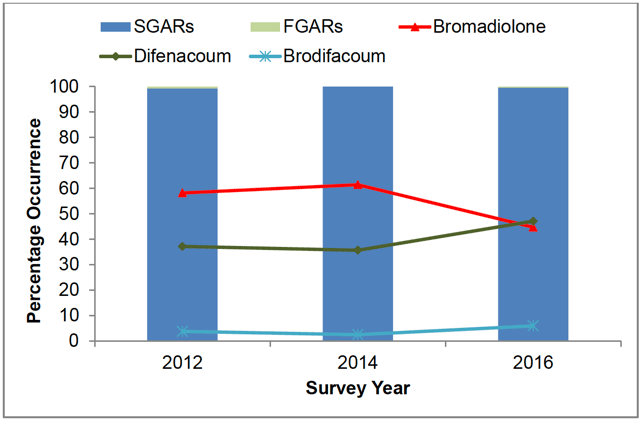
The use of brodifacoum, the third most commonly encountered rodenticide in this survey, has increased from one and three per cent of total occurrences in 2012 and 2014 respectively, to six per cent in 2016. Prior to 2016 all brodifacoum products, in addition to those containing difethialone and flocoumafen, were only authorised for use inside buildings. However, 2016 re-authorisations amended the approved location of use for many products containing these compounds. At the time of writing, the majority (96 per cent) of brodifacoum products are approved for use in and around buildings (3) . Whilst it is not possible to determine whether these changes in approval have influenced the increased occurrence of brodifacoum in the 2016 survey, they may affect future Scottish rodenticide use patterns.
Estimated weight of rodenticide used
Approximately 91 tonnes of rodenticidal products are estimated to have been used on Scottish arable farms in 2016 ( Table 2). In line with the occurrence data, more than 99 per cent of the total weight used was of SGAR containing products (Figure 6). Products containing bromadiolone were the most commonly used (ca. 44 tonnes), accounting for 49 per cent of total rodenticide use by weight. Difenacoum products were the second most commonly used (ca. 40 tonnes) accounting for 44 per cent of total use. Individual formulation weights, the weight of active substances present in the product not including baits, are also presented in Table 2. Anticoagulant rodenticide products contain very small amounts of active substance. The 91 tonnes of rodenticide used on arable farms in 2016 contained less than five kg of active substance, the remainder primarily being food bait used to attract rodents.
Figure 6 Estimated percentage weight of rodenticide product used on arable farms in Scotland 2016
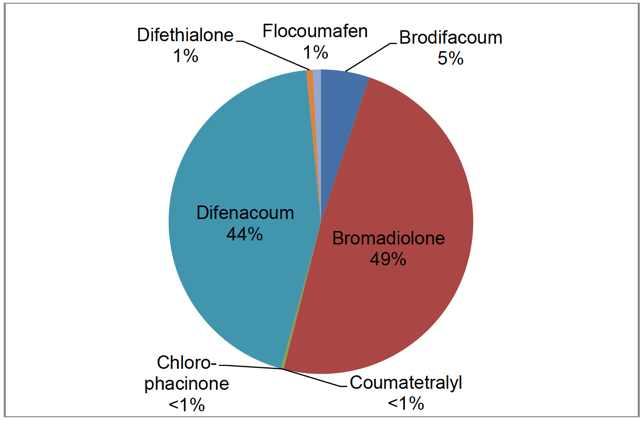
Note: as there were 10 or fewer occurrences of chlorophacinone, coumatetralyl, difethialone and flocoumafen in the sample, estimates of their use should be treated with caution
The estimated weight of rodenticides used on arable farms from 2012 to 2016 is presented in Figure 7. There has been a decrease in weight applied over these three surveys. Rodenticidal product use in 2016 (ca. 91 tonnes) was 19 per cent lower than in 2014 (ca. 113 tonnes) and 30 per cent lower than in 2012 (ca. 130 tonnes). This decline appears to be a continuation of a longer term trend of decreasing use in arable agriculture. The estimated use reported in this survey is 37 per cent lower than reported in 2000 (ca. 144 tonnes) (4) despite little change in the proportion of farms on which baiting is conducted (76 and 78 per cent in 2000 and 2016 respectively).
The reason for this apparent decline in quantity of rodenticide use is unclear, and it should be noted that rodent populations, and thus rodenticide use, fluctuate over time. However, declines may also have been influenced by the creation of the Campaign for Responsible Rodenticide Usage ( CRRU) and their guidance for best practice in 2005 and, in relation to the 2016 data, by the 2015 launch of the UK industry led rodenticide stewardship scheme (5) .
Figure 7 Estimated weight of anticoagulant rodenticide products used on arable farms in Scotland 2012 to 2016
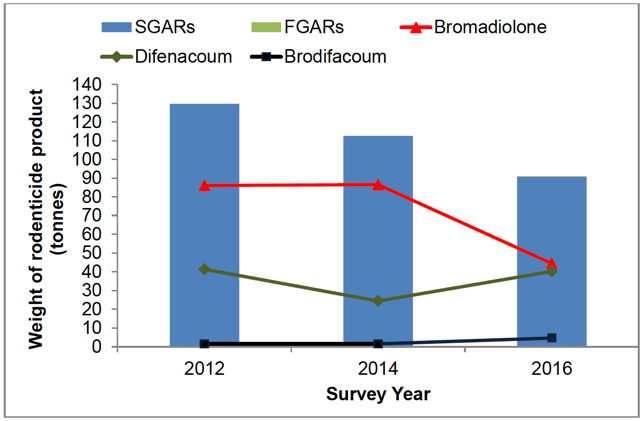
The majority of rodenticides applied by weight over the last three surveys have been bromadiolone and difenacoum, accounting for 98, 99 and 93 per cent of bait applied in 2012, 2014 and 2016 respectively. As with the occurrence data, the relative proportions of these two compounds have changed since the last survey (bromadiolone decreasing by 49 per cent, and difenacoum increasing by 65 per cent). Brodifacoum use has also increased more than threefold since the previous survey (1,497 kg and 4,696 kg in 2014 and 2016 respectively) representing one per cent of total product weight applied in 2014 and five per cent in 2016.
The reasons for the differences in use pattern of difenacoum and bromadiolone in 2016 are also unclear. It is possible that this may be a response to product efficacy in some areas; resistance to both difenacoum and bromadiolone has been reported in South West Scotland (6) . It may also simply represent a response to differences in the range of products available, and their marketing strategies over time.
In relation to brodifacoum usage, it is possible that the increase in 2016 may be influenced by the recent changes in approved use locations discussed in the previous section, particularly in areas where resistance to difenacoum and bromadiolone is an issue. However, it should also be noted that the volume of brodifacoum use in 2016 is not unprecedented, with similar levels recorded in 2004 and 2010 (4) .
Seasonal use of anticoagulant rodenticides
Season of use was specified for 95 per cent of all rodenticides surveyed (Figure 8). Forty six per cent of use was reported to occur throughout the year. This included farms practising permanent baiting and those conducting multiple separate baiting operations. This is a lower proportion than in both 2012 and 2014, when it was reported that 65 and 51 per cent of anticoagulant rodenticide use occurred throughout the year. When the weight used, including year-round use, is separated into season, the greatest use was in winter (39 per cent) with use decreasing during autumn, spring and summer. This is the same pattern reported in 2014 and 2012 (Figure 9).
Figure 8 Seasonal use of anticoagulant rodenticides on arable farms in Scotland 2016 (percentage of total weight)
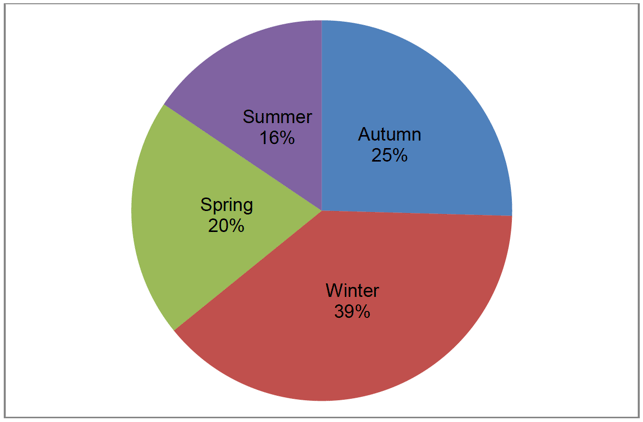
Figure 9 Seasonal use of anticoagulant rodenticides on arable farms in Scotland 2012 to 2016
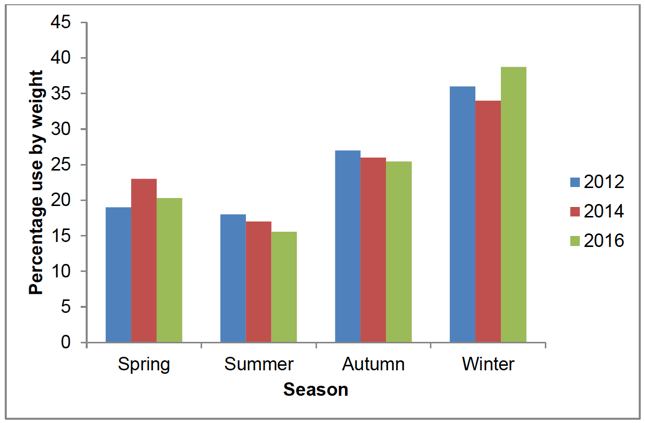
Rodenticide bait type and target of baiting
Baits formulated with grain were the most commonly encountered in this survey accounting for 86 per cent of use by weight (Figure 10). These baits were primarily loose grain and place packs containing grain, but also included a small amount of grain based paste and pelletized grain (less than one per cent of total grain baits).
The other types of rodenticide products encountered were wax baits which accounted for 12 per cent of use. All of the wax formulations were solid wax blocks. The next most frequently used type of rodenticide product was pasta based bait, contributing two per cent of total use. For the first time in this survey series, a foam rodenticide product was also encountered, this product was a contact rodenticide rather than bait, which is ingested by grooming.
Similar proportions of bait types were encountered in the previous two surveys (Figure 11). Grain baits made up 89, 93 and 86 per cent of rodenticidal baits used in 2012, 2014 and 2016 respectively.
Survey respondents were also asked to state the target of their rodenticide use (Figure 12). Where reason data were supplied the most common target was rats (58 per cent) followed by a combination of rats and mice (39 per cent). Only three per cent of use was targeted at mice alone. This is very similar to the targets reported in 2014 (60, 38 and two per cent for rats, rats/mice and mice respectively). Target data were not collected prior to 2014.
Figure 10 Type of rodenticide bait used on arable farms 2016 (percentage of total weight)

Note: There was one occurrence of a foam rodenticide product which is a contact rodenticide rather than bait; therefore it is not included in the above chart
Figure 11 Type of rodenticide bait used on arable farms 2012 to 2016
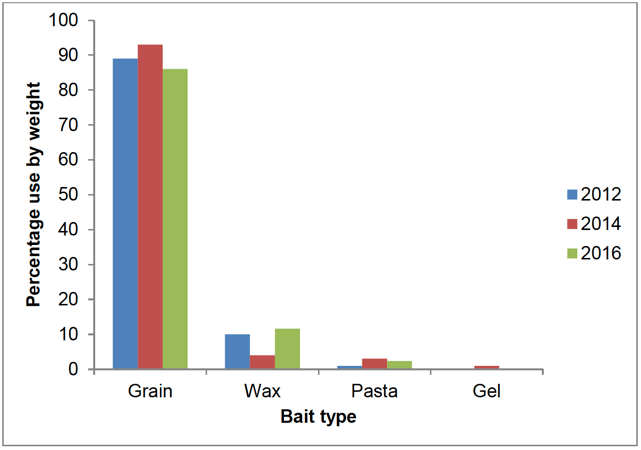
Figure 12 Target of rodenticide use on arable farms 2016 (percentage of total weight)
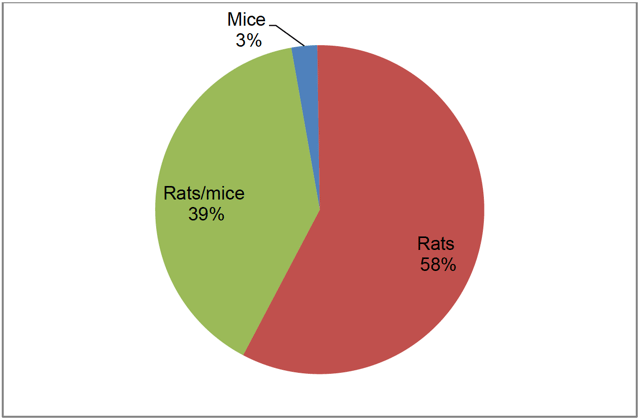
Non-chemical rodent control
Farmers were asked about non-chemical methods employed for rodent control (Figure 13). A range of measures were conducted, with some farmers employing more than one method.
On holdings on which rodenticides were not used (n=31), 61 per cent of the farmers reported using one or more non-chemical controls. The most commonly encountered method was use of cats (76 per cent of all methods reported). These farmers also reported that they used traps (19 per cent) and dogs (5 per cent) to control rodents.
On holdings using rodenticides (n=209), a lower proportion of farmers (26 per cent) reported that they used additional non-chemical methods of rodent control. Again, the most common methods used were cats (61 per cent of all methods reported) or traps (32 per cent), with lower use of dogs and shooting (four and three per cent respectively).
Two farmers, one who used rodenticides and one who did not, commented that predation by owls also reduced rodent numbers on their farms.
Figure 13 Non-chemical control methods used on arable farms 2016
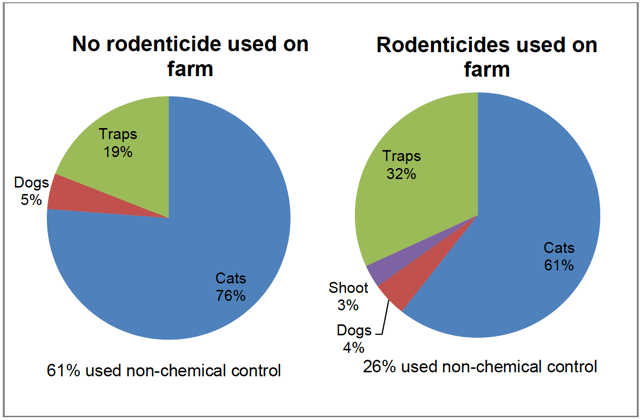
The number of farmers reporting that they employed non-chemical rodent control was greater in 2016 than in 2014. In 2014, 44 per cent of farmers who didn't use rodenticides, and 10 per cent of those who did, reported that they used non-chemical rodent control methods. The range of measures employed was similar to those encountered in the current survey. Uptake of non-chemical control was not collected prior to 2014.
Compliance with rodenticide best practice
All farmers and PCPs who were responsible for rodenticide baiting on the surveyed farms were provided with a questionnaire relating to their training history and their compliance with the principles of best practice of rodenticide use (7) ( Table 3).
Ninety nine per cent of farmers who conducted their own baiting (n=92) provided responses to the compliance questions. Seventy four per cent of the PCPs (n=23) also provided responses. These 23 PCP respondents were collectively responsible for baiting on 62 per cent of the farms (n=116) which used a contractor during this survey.
These data are expressed as percentage of respondents giving a positive answer to each question, where statistically significant differences in the response between farmers and PCPs were found these are noted.
All PCPs and 11 per cent of farmers had attended a training course on rodenticide use. The uptake of training was significantly different between farmers and PCPs (P<0.01).
All PCPs and 96 per cent of farmers stated that they recorded the quantity and location of baits, and all PCPs and farmers stated that these baits were protected from non-target animals. Bait was reported to be regularly inspected by all PCPs and 99 per cent of farmers.
Sixty one per cent of PCPs and sixty two per cent of farmers removed bait after targeted baiting periods.
All PCPs and 68 per cent of farmers stated that they searched for and removed rodent carcasses. Compliance with this element of best practice was significantly different between farmers and PCPs (P<0.01). Most respondents stated that they rarely saw carcasses. However, those who did employed a range of disposal methods including; incineration, burying, landfill and disposal in dung heaps and slurry pits.
The responses to these questions in 2016 are very similar to those provided in 2014 and 2012. The only notable difference is that in the past two surveys significantly more farmers (59 per cent in 2012 and 69 per cent in 2014, P<0.01) removed bait after targeted baiting periods than did PCPs (14 percent and 26 per cent respectively). In 2016 the response to this question was very similar between the two groups, with a greater number of PCPs stating that they removed bait at the end of the baiting period (61 per cent) and thus complying with best practice.
Farm operation data
Farmers were asked to respond to a series of questions relating to aspects of farm operation which might affect rodenticide use pattern ( Table 4). Ninety two per cent (n=240) of the farms surveyed provided this information; this represented 98 per cent of farms that used rodenticides and 87 per cent of those that did not.
The majority of respondents (92 per cent) were a member of a quality assurance scheme. A range of assurance schemes were encountered; the most common were Quality Meat Scotland ( QMS) and Scottish Quality Crops ( SQC). Both of these schemes specify that effective rodent control measures must be in place, although the use of anticoagulant rodenticides is not mandatory. Membership of both QMS and SQC also permitted purchase and use of rodenticide products authorised under stewardship conditions from April 2016 onwards during this survey. More farms that practised rodenticide baiting were members of a quality assurance scheme (97 per cent) than farms that did not use rodenticides (85 per cent) and this was significantly different (P<0.01).
Although all of the farms surveyed grew arable crops, some were also mixed farms and 53 three per cent of those surveyed kept livestock on their holdings, compared to 62 per cent in 2014. Very few of these farms reared pigs or poultry and those that did, did so on a small scale (these livestock sectors are particularly vulnerable to rodent infestations and so tend to be greater users of rodenticides). Farms that used rodenticides were not significantly more likely to have livestock than those that did not use rodenticides (57 and 41 per cent respectively).
Lastly, 62 per cent of holdings had an on-farm grain store, and a significantly greater number of farms using rodenticides had a grain store (68 per cent) than farms that did not use rodenticides (33 per cent) (P<0.01).
In 2014, unlike in 2016, there was no significant difference in quality assurance membership uptake between those farmers using or not using rodenticides. However, significantly more farmers who used rodenticides in 2014 had livestock on their farm, and had a grain store, than those that did not use rodenticides.
Rodenticide approval and stewardship
EU and UK Regulatory risk assessments have concluded that the use of First and Second Generation Anticoagulant Rodenticides ( FGARs and SGARs) outdoors present a higher level of risk to non-target animals (such as predatory birds and mammals) than would normally be considered acceptable. As a result, outdoor use of these rodenticides would not usually be approved. However the UK Government recognises that, despite these risks, outdoor use of anticoagulant rodenticides is necessary for rodent control.
In order to be able to re-authorise these rodenticides for use outdoors, Government must be assured that the risks will be properly managed to preclude unacceptable effects to non-target species. This is being addressed by an industry led stewardship scheme, managed by the Campaign for Responsible Rodenticide Use ( CRRU) (5) which was launched in 2015.
With the launch of the stewardship scheme providing environmental risk mitigation measures for rodenticide use, HSE has, during 2016, re-approved rodenticide product authorisations. As part of this re-authorisation the approval conditions for some products have been amended, notably in relation to the outdoor use of active substances that were previously restricted to use inside buildings (brodifacoum, flocoumafen and difethialone).
These changes may influence future rodenticide usage patterns, and indeed the increase in brodifacoum use in this survey may indicate that users are already reacting to the changes in authorisation. It is also possible, although too early to state conclusively, that the decreased rodenticide use, increased number of PCPs using targeted baiting periods and increased adoption of non-chemical control reported in 2016 may also have been influenced by introduction of the stewardship scheme and increased uptake of best practice.
Some additional questions were included in the 2016 survey to investigate knowledge and participation in the rodenticide stewardship scheme ( Table 5). All PCPs and 68 per cent of farmers were aware of the rodenticide stewardship scheme's existence. The response to this question was significantly different between farmers and PCPs (P<0.01).
Nine per cent of the farmers surveyed had attended a stewardship compliant training scheme which provided certification acceptable for point of sale purchase of professional rodenticide products. In addition, 51 per cent of farmers stated they intended to complete this training in future.
Farmers were also asked if they had purchased rodenticides after April 2016, when the product authorisations under stewardship had been implemented. Of the 38 farmers who purchased rodenticides post April 2016, the majority (29) did so by demonstrating membership of a compliant quality assurance scheme. Five purchased non-professional rodenticide products and three purchased non-stewardship products (which were available until September 2016).
Contact
There is a problem
Thanks for your feedback